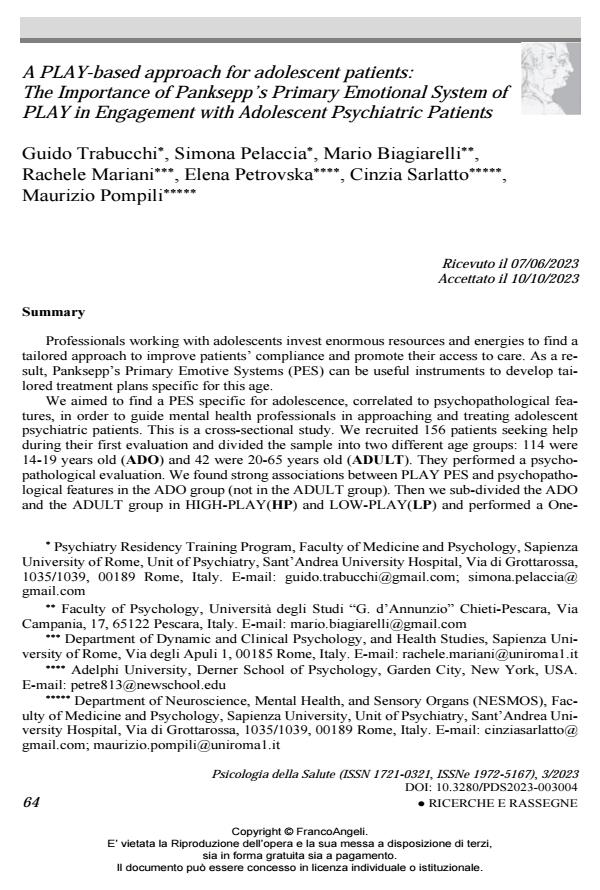A PLAY-based approach for adolescent patients: The Importance of Panksepp’s Primary Emotional System of PLAY in Engagement with Adolescent Psychiatric Patients
Titolo Rivista PSICOLOGIA DELLA SALUTE
Autori/Curatori Guido Trabucchi, Simona Pelaccia, Mario Biagiarelli, Rachele Mariani, Elena Petrovska, Cinzia Sarlatto, Maurizio Pompili
Anno di pubblicazione 2023 Fascicolo 2023/3
Lingua Inglese Numero pagine 21 P. 64-84 Dimensione file 315 KB
DOI 10.3280/PDS2023-003004
Il DOI è il codice a barre della proprietà intellettuale: per saperne di più
clicca qui
Qui sotto puoi vedere in anteprima la prima pagina di questo articolo.
Se questo articolo ti interessa, lo puoi acquistare (e scaricare in formato pdf) seguendo le facili indicazioni per acquistare il download credit. Acquista Download Credits per scaricare questo Articolo in formato PDF

FrancoAngeli è membro della Publishers International Linking Association, Inc (PILA)associazione indipendente e non profit per facilitare (attraverso i servizi tecnologici implementati da CrossRef.org) l’accesso degli studiosi ai contenuti digitali nelle pubblicazioni professionali e scientifiche
Professionals working with adolescents invest enormous resources and energies to find a tailored approach to improve patients’ compliance and promote their access to care. As a re-sult, Panksepp’s Primary Emotive Systems (PES) can be useful instruments to develop tai-lored treatment plans specific for this age. We aimed to find a PES specific for adolescence, correlated to psychopathological fea-tures, in order to guide mental health professionals in approaching and treating adolescent psy-chiatric patients. This is a cross-sectional study. We recruited 156 patients seeking help during their first evaluation and divided the sample into two different age groups: 114 were 14-19 years old (ADO) and 42 were 20-65 years old (ADULT). They performed a psychopatholog-ical evaluation. We found strong associations between PLAY PES and psychopathological features in the ADO group (not in the ADULT group). Then we sub-divided the ADO and the ADULT group in HIGH-PLAY(HP) and LOW-PLAY(LP) and performed a One-Way ANOVA. In the ADO group, we found significant differences between HP and LP group psychopathological features, but the same was not found in the ADULT group. PLAY is an emotive system that is highly correlated with psychopathological features in our sample of adolescents seeking help. This correlation was not found in ADULT patients. For these results, we suggested PLAY can be a useful instrument to treat help-seeking adoles-cents with mental health issues.
Gli operatori che lavorano con gli adolescenti investono enormi quantità di risorse ed energie per identificare un approccio personalizzato per migliorare la collaborazione dei pazien-ti e intensificare l’accesso alle cure. I Sistemi Emotivi di Base di Panksepp possono essere de-gli utili strumenti per sviluppare trattamenti personalizzati specifici per questa popolazione. Lo scopo del lavoro è identificare un Sistema Emotivo di Base specifico per la popolazione adolescenziale correlato a manifestazioni psicopatologiche, per poter guidare gli operatori della salute mentale nell’approccio e nel trattamento dei pazienti psichiatrici adolescenti. Questo è uno studio cross-sectional. Abbiamo reclutato 156 pazienti help-seeker e quindi abbiamo divi-so in due gruppi per età: 114 avevano 14-19 anni (ADO) e 42 avevano 20-65 anni (ADULT) e sottoposti a batteria testologica. Abbiamo trovato una forte associazione tra PLAY e le mani-festazioni psicopatologiche solo nel gruppo ADO e non nel gruppo ADULT. Quindi abbiamo suddiviso i gruppi in un gruppo HIGH-PLAY (HP) e LOW-PLAY (LP) ed effettuato un test One-Way ANOVA. Nel gruppo ADO abbiamo identificato differenze significative nelle ma-nifestazioni psicopatologiche tra i gruppi HP e LP e non nel gruppo ADULT. PLAY è un Sistema Emotivo di Base che è altamente correlato con le manifestazioni psi-copatologiche nel nostro gruppo di adolescenti. Questa correlazione non è stata identificata nel gruppo di adulti. Alla luce di questi risultati, abbiamo suggerito che PLAY possa essere un utile strumento per il trattamento di adolescenti con disagio mentale.
Parole chiave:psichiatria adolescenziale, neuroscienze affettive, sistemi emotivi di base, psi-copatologia, relazione terapeutica.
Guido Trabucchi, Simona Pelaccia, Mario Biagiarelli, Rachele Mariani, Elena Petrovska, Cinzia Sarlatto, Maurizio Pompili, A PLAY-based approach for adolescent patients: The Importance of Panksepp’s Primary Emotional System of PLAY in Engagement with Adolescent Psychiatric Patients in "PSICOLOGIA DELLA SALUTE" 3/2023, pp 64-84, DOI: 10.3280/PDS2023-003004